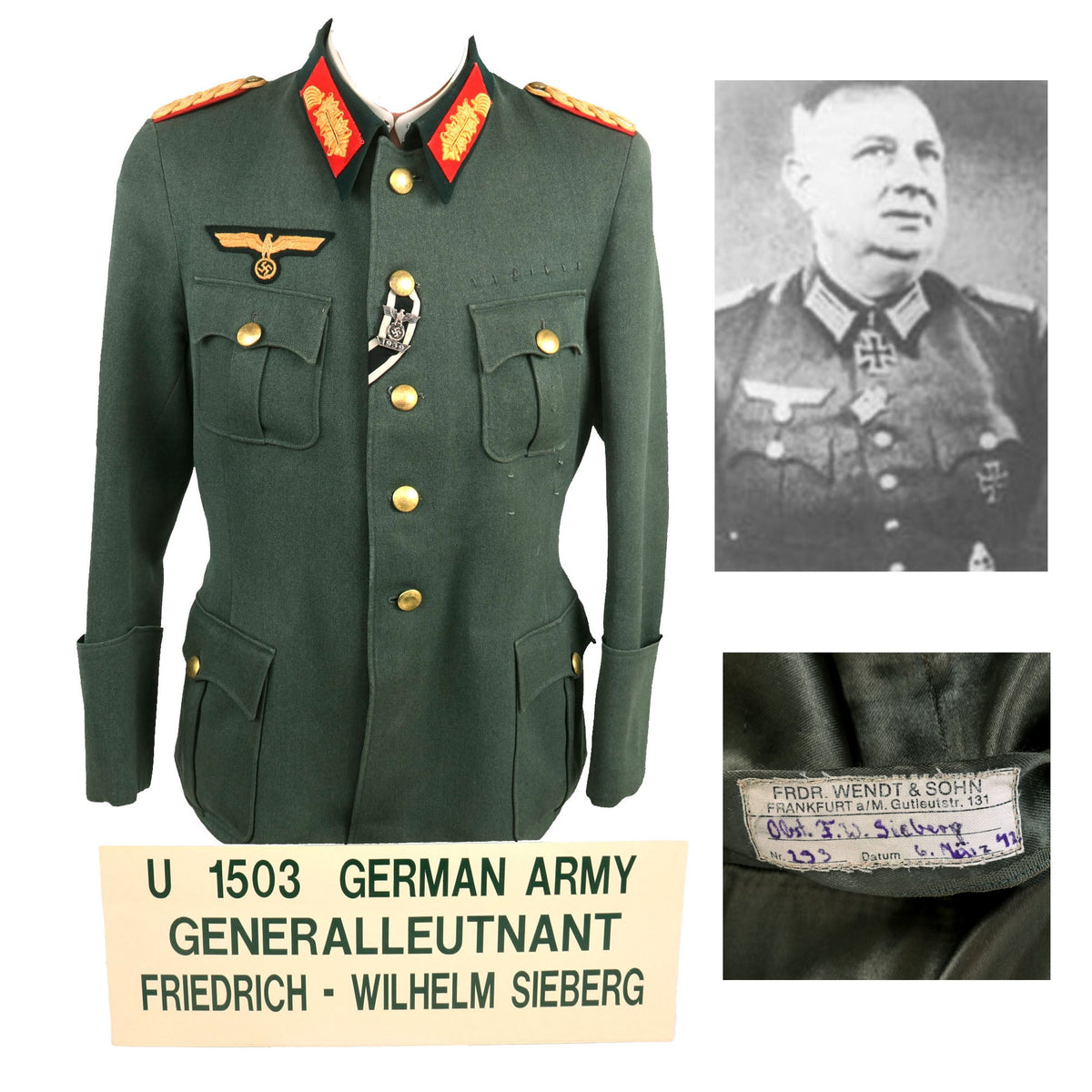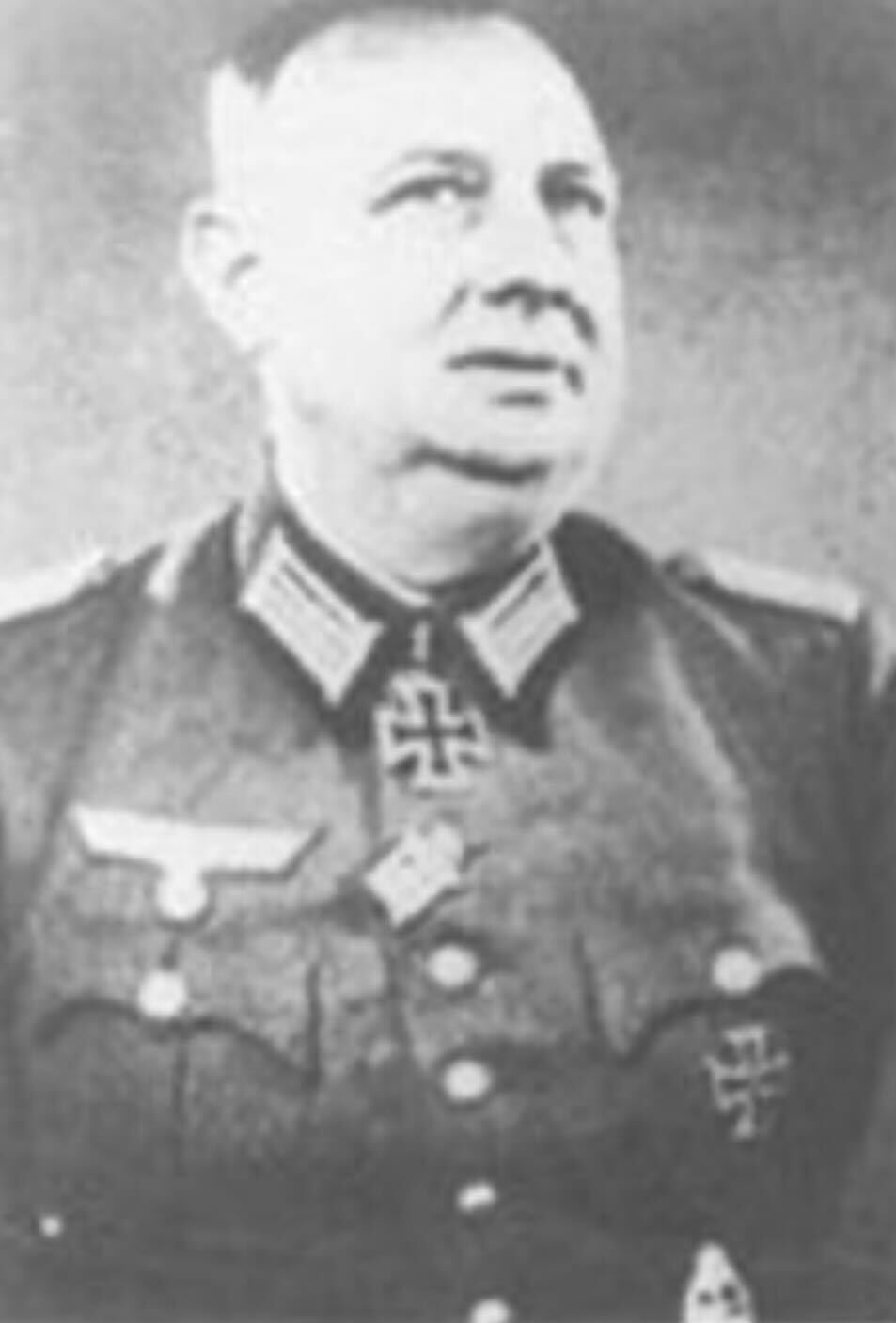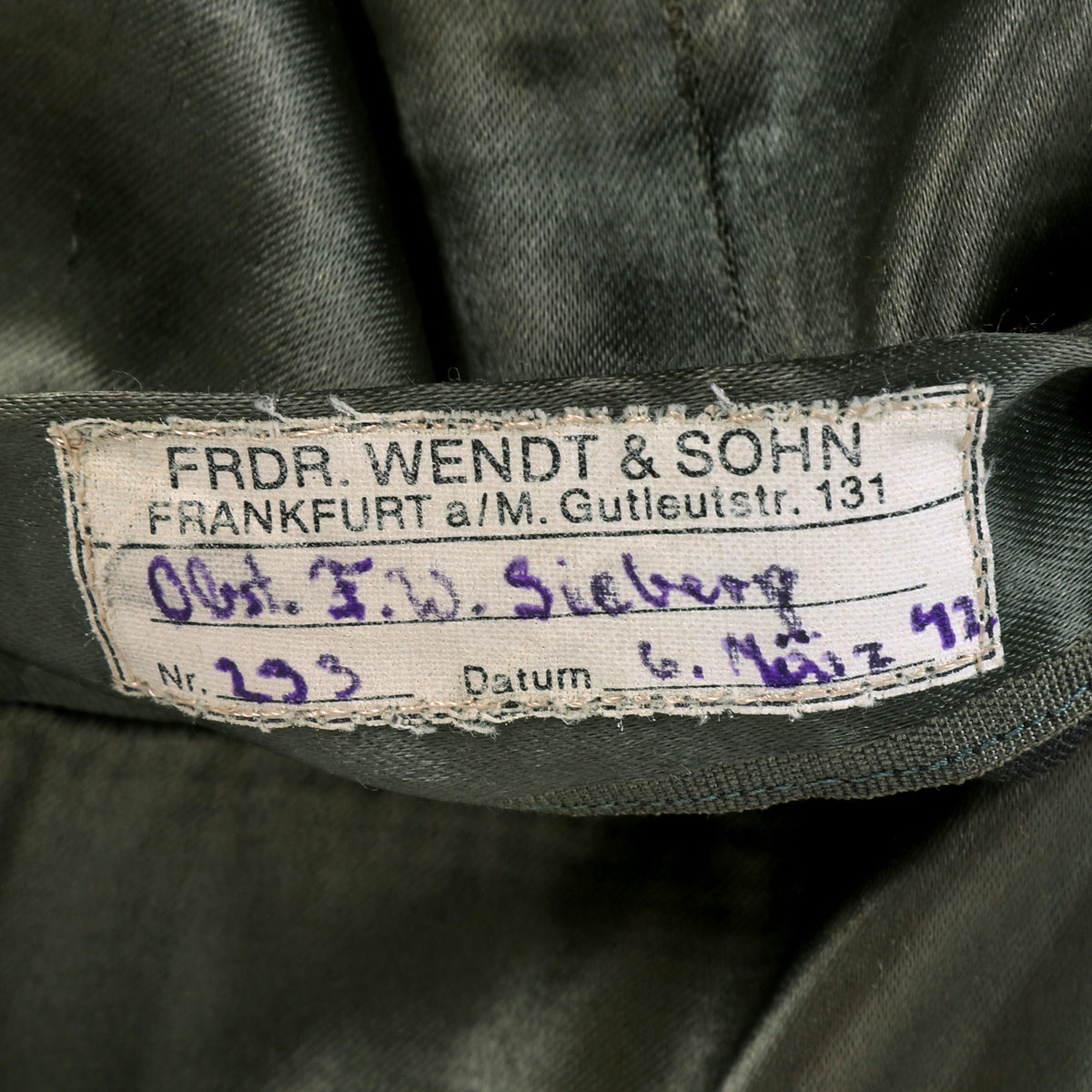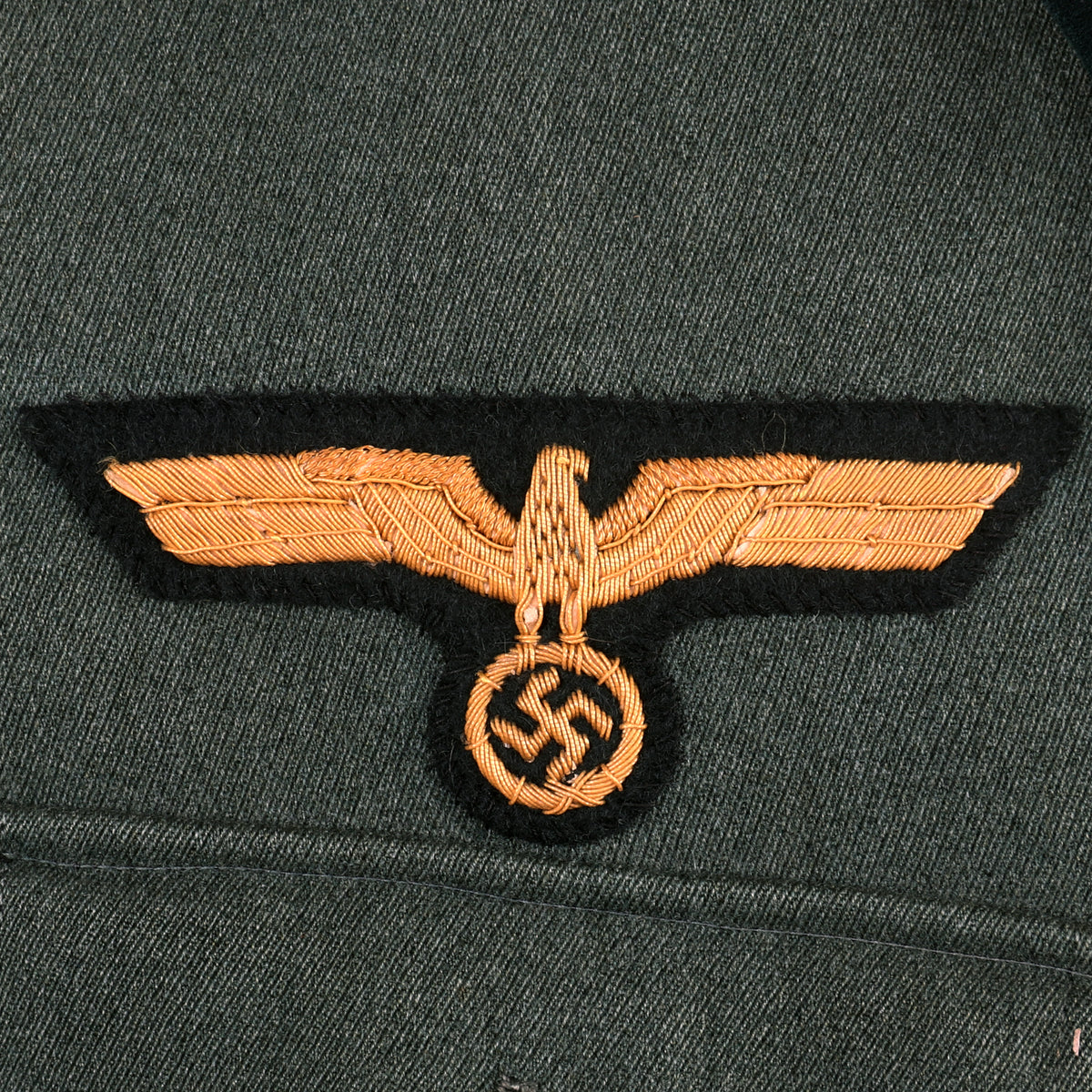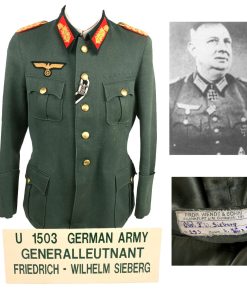Original German WWII 14th Panzer Division Commander Generalleutnant Friedrich W. Sieberg Uniform Tunic – Formerly Part of the A.A.F. Tank Museum Original Items
$ 7.995,00 $ 1.998,75
Original Items: One-of-a-kind set. Friedrich Wilhelm Sieberg (15 February 1896 – 3 November 1943), usually shortened to Friedrich Sieberg, was a German Generalleutnant in the Heer Army during World War II. He was commander of the 10th Panzer Regiment early in the war, and then spent much of 1940-1942 on staff at one of the Panzer Training schools. He then was made commander of the 14th Panzer Division from 1 April 1943 until 29 October 1943, when he was severely wounded, later passing away several days later at Kirowograd Military hospital.
Sieberg most likely began the war ranked as a Major, and then was promoted through the ranks during the war, eventually being promoted to Generalmajor (Brigadier General) when commending the 14th Panzer Division. It looks like his promotion to Generalleutnant (Major General) occurred two days prior to his death, after his injury, so it was almost an honorary promotion, given on his deathbed. He was a recipient of the Knight’s Cross of the Iron Cross, and probably received other prestigious awards, however there is unfortunately not much detailed information out there on his service, probably because he died mid way through the war.
This wonderful German WWII Named Uniform Set came to us from the American Armoured Foundation, Inc. Tank and Ordnance Memorial Museum. The AAF Tank Museum was a living memorial dedicated to the Tank and Cavalry soldiers of the world. Before 1981 some of the artifacts that make up the AAF Tank Museum was a private collection belonging to Mr. William Gasser. Mr. Gasser felt that his collection would be beneficial in educating present and future generations to the sacrifices made and the technologies gained during war. Therefore, in 1981 the AAF Tank Museum was established as a non-profit charitable organization, and Mr. Gasser’s donated his private collection to the Tank Museum. Mr. Gasser is still active as Volunteer Director and Curator of the Tank Museum and his knowledge of military history has been a great asset to the museum. Unfortunately after 20 years of operation it had to close its doors, which is when this set was acquired.
Born 15 February 1896, as with most able bodied Germans Friedrich Sieberg joined the military during WWI, enlisting 18 August 1914 after the conflict had started. He would be promoted to Leutnant on 6 November 1915, while a member of the 174th (10th Lotharingian) Infantry Regiment, however there is not much other information about his WWI service, other than that he received the Iron Cross 1914 Second Class at some point.
We cannot find any records of Sieberg serving in the Reichswehr during the Weimar republic, and he is next noted as being a member of I. / Panzer Regiment 10 on 15 July 1938, which he would later command as an Oberstleutnant before becoming commander of the entire regiment on 23 October 1939. After this, he was awarded the Knight’s Cross of the Iron Cross on 16 June 1940 as the Kommandeur Panzer-Regiment 10, with the following citation information:
“Oberstleutnant Sieberg… has done a masterful job of leading his Regiment throughout the entire campaign in France. His personal courage and exemplary conduct under enemy fire inspired his men to perform deeds that were as devastating for the enemy as they were glorious for the Division. He drove alongside the spearhead of the Division during the pursuit towards Montreuil, and up until midnight he led his Panzer-Abteilungen in repeated thrusts behind the fleeing enemy. With such leadership the success was overwhelming. The Division pushed about 20 km beyond its day’s objective, and in the process it captured thousands of prisoners as well as heavy artillery and vehicles of all kinds. He thereafter led his Regiment during the attack across the La-Bassée Canal with great initiative. In this time he thrust forwards to Hazebrouck with his collection of units, destroyed the enemy artillery located there and thereby enabled the Division’s infantry to secure the bridgehead it had been tasked with seizing.”
It should also be noted that due to his long service he would have qualified for the Wehrmacht Long Service awards, and other awards not listed. There is no medal bar on this uniform, but there are numerous thread loops above the left breast pocket where it would have been, as well as additional thread loops under the pocket for additional awards. The second buttonhole from the top is fitted with a 1914 Iron Cross 2nd Class ribbon, which has a 1939 Clasp of the Iron Cross attached to it.
The lovely M36 uniform tunic in this set was is a lovely bespoke example, made for Siebert in March of 1942, when he was an Oberst following his promotion on 1 December 1941. It is a lovely bespoke example with a clear maker label inside of the left inside pocket, which reads (handwritten parts italicized):
FRDR. WENT & SOHN
FRANKFURT a/M. Gutleutstr. 131
——————-
Obst. F. W. Sieberg
Nr. 233 Datum 6. März 42.
This would have been from when Sieberg was at the Panzer Training School, and indicates that when he was promoted to Generalmajor during 1943, he had the staff officer insignia removed, and replaced with the correct General grade collar tabs, eagle, and shoulder boards. This would have been done by a tailor, and it is nearly impossible to tell that they were replaced during the war.
The tunic is really a great example of a private purchased Wehrmacht Heer Dienstbluse (Service Tunic), originally made for a Stabsoffiziere (Staff Officer) but upgraded to be for a Generäle (General Officer). It is constructed from a fine quality field-gray “whipcord” wool woven exterior, with an olive green cotton-rayon blended faux silk interior lining. There is a left interior slash pocket, and also the usual hanger clip for an officer’s dagger, which lines up with the large “eyelet” that is part of the left waist pocket. The sleeves are lined with white rayon with blue stripes, which is typical.
The collar is constructed of flaschengrün (dark bottle-green) wool, and is adorned by a set of General grade collar tabs, known as alt-Larisch or Arabesque style, which were used for all General ranks below Feldmarschall. These have the correct red backgrounds with gold bullion embroidery. There is also a white collar insert attached with two of the three original pins, used to prevent wear to the delicate wool. The tunic conforms well to the M36 pattern having 4 pleated pockets on the front with scalloped flaps. All of the pebbled buttons are the correct gold color for a General officer, and all look to be marked EXTRA FEIN on the back.
Each shoulder is decorated with the sew-on style Generalmajor rank shoulder boards. They are both constructed out of a row of interwoven silver and gold bullion strands in the typical Russian braid style in an interlocking weave pattern ending at a pebbled gilt button. There are no rank pips installed, correct for a Generalmajor, which is the rank that Sieberg held until his promotion 2 days prior to his death.
On the right breast is a fine quality gold bullion eagle, constructed of rolled, twisted, and flat hand embroidered gilt stitching with gold bullion retaining threads, placed onto a dark bottle green wool backing. It is neatly stitched to the outer layer of fabric, which is still bright and shiny. There are also the previously mentioned Iron Cross ribbon on the second buttonhole, as well as thread loops around the left breast pocket. Really a lovely looking tunic, showing just a bit of wear.
Along with the uniform we received the original painted metal display placard used when the uniform was owned and displayed by the A.A.F. Tank Museum. This shows the asset tag number, and really adds to the display potential.
We were also able to find just ONE photographs of Sieberg on the internet, which looks to possibly show him wearing this very tunic! This is shown for illustrative purposes only and is not included.
We very seldom get uniform tunics with such great provenance and potential for further research. This could become the centerpiece of your WWII collection. Ready to research and display!
Approximate Measurements:
Collar to shoulder: 9″
Shoulder to sleeve: 24”
Shoulder to shoulder: 14”
Chest width: 19″
Waist width: 22″
Hip width: 22″
Front length: 29″
More on Friedrich W. Sieberg’s Service:
Promotions:
● Oberstleutnant – Lt. Colonel – 1 January 1939
● Oberst – Colonel – 1 December 1941
● Geneneralmajor – Brigadier General – 1 June 1943
● Generalleutnant (Nachtrupp) – Major General (Support) – 1 November 1943
Commands Held:
● I. / Panzer Regiment 10 – 1 September 1939
● Panzer Regiment 10 – 23 October 1939
● at Panzer Tr. Schule – 11 August 1940
● Kdr.d.takt.Lehrg.d.Pan.Tr.Schule – 20 February 1942
● 14. Panzer-Division – 1 April 1943 – 29 October 1943 (severely wounded)
More on German Uniform Tunics
Terms such as M40 and M43 were never designated by the Wehrmacht, but are names given to the different versions of the Model 1936 field tunic by modern collectors, to discern between variations, as the M36 was steadily simplified and tweaked due to production time problems and combat experience.
Field Tunic (Feldbluse) Model 1936
When the NSDAP came to power in early 1933 the Reichswehr, the armed forces of the Weimar Republic, were near the end of a two-year project to redesign the Army Feldbluse (field-blouse). Beginning in that year the new tunic was issued to the Reichsheer and then the rapidly growing Wehrmacht Heer, although minor design changes continued to be made until the appearance of the standardized Heeres Dienstanzug Modell 1936. The M36 tunic still retained the traditional Imperial and Reichswehr uniform color of grey-green “field gray” (feldgrau) wool, but incorporated four front patch pockets with scalloped flaps and pleats (on Reichswehr tunics the lower pockets were internal and angled). The front was closed with five buttons rather than the previous eight, and the collar and shoulder straps were of a dark bottle-green instead of the Reichswehr grey. Compared to the Weimar-era uniforms the skirt of the feldbluse was shorter and the tailoring was more form-fitting due to Germany’s adoption of mechanized warfare: soldiers now spent much time in the confined space of a vehicle and a shorter jacket was less likely to pick up dirt from the seats. It also included an internal suspension system, whereby a soldier could hang an equipment belt on a series of hooks outside of the tunic. These hooks were connected to two straps inside the lining, which spread the weight of equipment without having to use external equipment suspenders. The M36 was produced and issued until the very end of the war, though successive patterns became predominant.
Fast Shipping with Professional Packaging
Thanks to our longstanding association with UPS FedEx DHL, and other major international carriers, we are able to provide a range of shipping options. Our warehouse staff is expertly trained and will wrap your products according to our exact and precise specifications. Prior to shipping, your goods will be thoroughly examined and securely secured. We ship to thousands clients each day across multiple countries. This shows how we're dedicated to be the largest retailer on the internet. Warehouses and distribution centres can be located throughout Europe as well as the USA.
Note: Orders with more than one item will be assigned a processing date depending on the item.
Before shipping before shipping, we'll conduct a thorough inspection of the items you have ordered. Today, the majority of orders will be delivered within 48 hours. The delivery time will be between 3-7 days.
Returns
The stock is dynamic and we cannot completely manage it because multiple stakeholders are involved, including our factory and warehouse. So the actual stock may alter at any time. It's possible that you may not receive your order once the order has been made.
Our policy is valid for a period of 30 days. If you don't receive the product within 30 days, we are not able to issue a refund or an exchange.
You can only return an item if it is unused and in the same state as the day you received it. You must have the item in its original packaging.
Related products
Uncategorized
Armored Burgonet Helmet & Polearm from Scottish Castle Leith Hall Circa 1700 Original Items
Uncategorized
Uncategorized
Uncategorized
Uncategorized
Armoured Fighting Vehicles of the World: AFVs of World War One (Hardcover Book) New Made Items
Uncategorized
Uncategorized
Uncategorized
Uncategorized
Uncategorized
Uncategorized
Uncategorized
Uncategorized
Band of Brothers ORIGINAL GERMAN WWII Le. F.H. 18 10.5cm ARTILLERY PIECE Original Items
Uncategorized
Uncategorized
Uncategorized
Uncategorized
Angolan Rebel 1970s era 60mm Inert Display Mortar from Angolan Civil War Original Items
